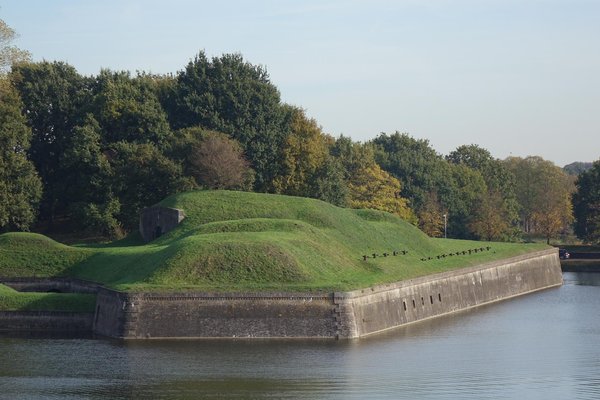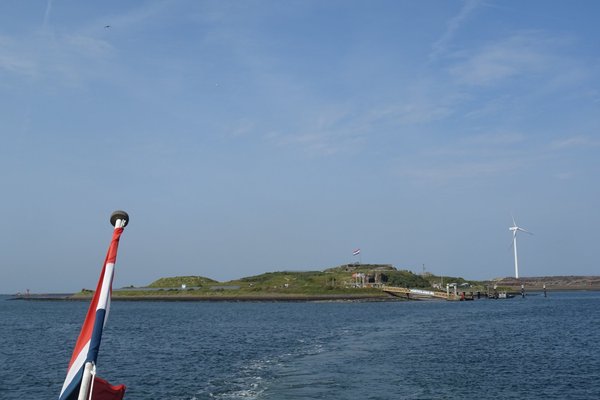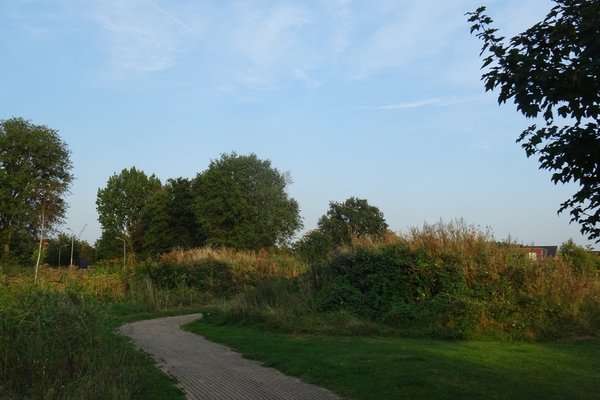Netherlands
Dutch Water Defence Lines
The Dutch Water Defence Lines were a system of military fortifications based on the control of water.
The fortifications consisted of a network of forts combined with the temporary flooding of polders via a system of canals and locks that were originally built for civil use. The two major defense lines were the New Dutch Waterline and the Defense Line of Amsterdam, built in the 19th and early 20th centuries to protect the country's economic center and capital.
Community Perspective: “As a casual tourist I wouldn’t suggest the sites themselves are really worth trekking out to see..” was Ian’s verdict in 2006, but 18 years later, he enjoyed the Waterliniemuseum. Many of the forts now have a different use (restaurant, art centre) and are in various states of repair. It is hard to recommend a specific component for a satisfying visit. Just pick 1 or 2 near Amsterdam, Utrecht or Haarlem. Be aware that many more forts are inscribed than the 20 officially named locations, since it is a linear inscription. Oh, and don't forget this car park, which is a double WHS!
Site Info
Official Information
- Full Name
- Dutch Water Defence Lines (ID: 759)
- Country
- Netherlands
- Status
-
Inscribed 1996
Site history
History of Dutch Water Defence Lines
- 2021: Extended
- With more Dutch Water Defense Lines
- 2021: Advisory Body overruled
- ICOMOS advised a Referral on the proposed Extension.
- 2021: Name change
- From Defence Line of Amsterdam to Dutch Water Defence Lines
- 2018: Revision
- Clarifications of property boundaries, removing Fort Kijkuit which has never been part of the Defence Line of Amsterdam (but does belong to the Nieuwe Hollandse Waterlinie TWHS and possible extension)
- 1996: Inscribed
- Inscribed
- Type
- Cultural
- Criteria
- ii
- iv
- v
Links
- UNESCO
- whc.unesco.org
- Official
-
- stellingvanamsterdam.nl — Defence Line
- Related
-
- natuurmonumenten.nl — Fort bij Abcoude
- pampus.nl — Forteiland Pampus
- fortspijkerboor.nl — Fort bij Spijkerboor
All Links
UNESCO.org
- whc.unesco.org — whc.unesco.org/
Official Website
- stellingvanamsterdam.nl — Defence Line
Related Resources
- natuurmonumenten.nl — Fort bij Abcoude
- pampus.nl — Forteiland Pampus
- fortspijkerboor.nl — Fort bij Spijkerboor
News Article
- June 28, 2013 parool.nl — 4.5 million EUR for restoration forts Defence Line Amsterdam
Community Information
- Community Category
- Secular structure: Military and Fortifications
Travel Information
Exact locations inscribed twice (or more)
Five forts and three sluices also belong to the Beemster Polder. Also, the components …
Amsterdam hotspot
Recent Connections
-
Prison
Parts of the Dutch Water Defence Lines …
-
Universities
Fort Hoofddijk: not only is the Fort i…
-
Perfect Inscriptions
1996
Connections of Dutch Water Defence Lines
- Individual People
-
-
Louis XIV
the old defense line was created as reaction to Louis' attack on Amsterdam
-
- Geography
-
-
North Sea
Pampus is a fort on a man-made island situated on what was the Pampus shallows or sandbank in the then Zuiderzee (a shallow bay of the North Sea until 1932) -
Linear inscriptions
The AB evaluation states "It may also be considered to be a linear Cultural Landscape, as defined in the Operational Guidelines (1995, paragraphs 35-39)". The full artifact is described thus :- "The defensive line of the Stelling van Amsterdam is roughly Circular, on a radius of approximately 15 km from the city centre, and extends over two provinces. The main defence line is c. 135 km long and comprises 45 forts, with a number of ancillary works." It is not absolutely clear however whether the inscribed area is linear or consists just of specific points -or a mixture. The AB eval states "The area proposed for inscription runs continuously in a 3-5 km wide zone from Edam, north of Amsterdam, to Muiden, to the east of the city, and out to the PamPuS island fort in the IJmeer, Passing through twenty-six municipalities. It includes forty-five forts and many smaller works." -
Offshore of a major city
The fortified island of Pampus stands in the IJMeer 12 kms offshore of Amsterdam (although this "sea" is now cut off from open waters by the Houtribdijk and Afsluitdijk). It is reached by ferry from Muiden
-
- Trivia
-
-
Michelin-starred restaurants in Monuments
Restaurant Kasteel Heemstede (*) in Houten -
Tour de France
1954 Stage 1 crossed though the corezone, probably around Abcoude) -
Cultural sites taking up an entire island
Pampus Island
-
- Architecture
-
-
Star fort
Naarden, Weesp, Muiden -
Brick architecture
Fort near Abcoude, Muiden Fortress -
Reinforced Concrete
The invention of the brisance grenade (which would explode on impact of the target) necessitated the change from masonry to concrete forts.
-
- World Heritage Process
-
-
Sites for which a reduction is or was planned
At the 2021 extension, 7 areas from the original WHS were proposed to be removed. ICOMOS agreed on 6 out of the 7. -
Extended
2021: With more Dutch Water Defense Lines -
Exact locations inscribed twice (or more)
Five forts and three sluices also belong to the Beemster Polder. Also, the components "Bunnik-Vechten | Marsdijk" and "Bunnik-Vechten | Provincialeweg" of The Lower German Limes are part of the Dutch Water Defence Lines too. At the parking lot of Restaurant Vroeg you're in both WHS.
-
Perfect Inscriptions
1996
-
- Human Activity
-
-
Artificial Islands
Pampus (former shallow area made into a "proper" island) -
Polders
Several of the elements making up the site are related to Polders e.g "Engineers' dike through the Haarlemmermeer polder The large Haarlemmermeer polder was split into two by an engineers' dike about 15 kilometres from the centre of Amsterdam. Built between 1890 and 1895 it is 10.5 kilometres long and it allowed the southern half of the polder to be inundated while the remaining half stayed dry." And "Fort near Hoofddorp In the middle of the Haarlemmermeer polder and the Engineers' dike, this fort was built between 1903 and 1904. Because of limited space and the depth of the polder, a two level bomb proof building was built with a deep moat and a special machine gun post to cover the deep moat."
-
- Constructions
-
-
Lighthouses
Battery near the IJ before Durgerdam (vuurtoreneiland) -
Casemates
At Muiden and Weesp -
Canals
"... canals nave been built to drain the land" (AB ev) -
Moats
"A fort ensemble consisted of linked concrete buildings on an island defined by a moat" (AB ev 1996) -
Prison
Parts of the Dutch Water Defence Lines have been used a a prison. Very famous in the Netherlands (in the Canon of Dutch History) is that Loevestein Castle was a state prison in the 17th century in which Hugo de Groot was kept as political prisoner. After WWII some of the forts have been used as a prison, like Fort near Edam.
-
- Timeline
-
-
Built in the 19th Century
built 1883-1920
-
- WHS Hotspots
-
-
Amsterdam hotspot
Muiden Castle for example lies only 40min by bus from Amsterdam Central Station
-
- Science and Technology
-
-
Universities
Fort Hoofddijk: not only is the Fort inside the Botanical Gardens of Utrecht University. The university is actually also in the Fort. Since the early sixties, the Fort houses the university's Paleomagnetic Laboratory of the dept. of Earth Sciences.
-
Botanical Gardens
Botanische Tuin Fort Hoofddijk (Utrecht University Botanic Gardens, 1964)
-
- WHS Names
-
-
Name changes
From "Defence Line of Amsterdam" to "Dutch Water Defence Lines" (2021)
-
News
- parool.nl 06/28/2013
- 4.5 million EUR for restoration fo…
Recent Visitors
Visitors of Dutch Water Defence Lines
- Adam Hancock
- Adrian
- Adrian Turtschi
- Alexander Barabanov
- Alexander Lehmann
- Alex Baranda
- alicemears
- Ali Zingstra
- A. Mehmet Haksever
- Ammon Watkins
- amychemu
- Ana Lozano
- Antonio J.
- Argo
- ArnaudFilloux
- Artur Anuszewski
- Ask Gudmundsen
- Aspasia
- Assif
- Astraftis
- Atila Ege
- Avery MC
- AYB
- basementonline
- BaziFettehenne
- Bernard Joseph Esposo Guerrero
- Bill Maurmann
- Bin
- BJGreasly
- BobSmithseestheworld
- Boj
- Bram de Bruin
- brendairala
- Brendan Carroll
- Bropyk
- c82wc1
- CampbellME
- Can SARICA
- Caspar
- Cezar Grozavu
- Chantal den Haan
- chenboada
- Cheryl
- Chinmaya
- ChrisDorn
- Christer Sundberg
- christof
- Christoph
- Christravelblog
- Claire Bradshaw
- Cluckily
- Clyde
- Colossus
- Coppi
- Corinne Vail
- crilly
- Cristina Erba
- Csaba Nováczky
- Dagmara
- Damientournay
- Dani Cyr
- Daniela Hohmann
- Daniel Chazad
- David Aaronson
- David Berlanda
- David Marton
- DavidS
- del
- Digits
- Dimitar Krastev
- Dirk-pieter
- DjhMck
- Dolemite92
- Dorejd
- Dr. Caligari
- DutchHorn
- Dwight Zehuan Xiao
- Echwel
- Elf21
- Elis
- Elisabeth Fransisca Situmorang
- Ellen Nielsen
- Els Slots
- Enid MC
- Erik G
- Erik Jelinek
- Errol Neo
- Eva Kisgyorgy
- Evgenii
- Fan Yibo
- Feldhase
- Felicité
- Femke Roos
- Flexiear
- forest80
- FrankW
- Frederik Dawson
- FS
- Galgalula
- Gary Arndt
- Geert Luiken
- George Gdanski
- GeorgeIng61
- grimloch
- Hammeel
- HaraldOest
- Harry Mitsidis
- heywhatever2
- Hubert
- Hurrvinek
- Iain Jackson
- Ian Cade
- Ilya Burlak
- Ingemar Eriksson
- Ingrid
- Ivan
- Ivan Rucek
- Jacob Choi
- Jakob F.
- Jana and Matt
- Janina Lehmann
- janis
- Jan-Willem
- Jan Zimmermann
- Jarek Pokrzywnicki
- Jasam
- Javier Coro
- Jawnbeary
- Jay T
- jballard650
- Jean Lecaillon
- Jeanne OGrady
- Jens
- Jesse S 2010
- Jezza
- J_neveryes
- JobStopar
- Joebobs
- Joel on the Road
- Jonas Hagung
- Jonas Kremer
- jonathanfr
- Jon Eshuijs
- jonstst
- JoStof
- Joyce van Soest
- Jurre
- jxrocky
- KarenBMoore
- Kasia M.
- Kasper
- Kbecq
- Kevin Padley-Knight
- Kjlauer
- Klaus Freisinger
- Knut
- Krijn
- Kurt Lauer
- Lado Joel
- Laetitia Yin
- Lameduck99
- Lara Adler
- leroykstlj
- Lisu Marian
- ljowers
- Loic Pedras
- Luboang
- Lucio
- Ludvan
- Luis Filipe Gaspar
- Lukasz Palczewski
- lynnz317@aol.com
- Maciej Gil
- Maciej Gowin
- Mahuhe
- MarcoB_0
- Marcobrey
- Marlies van Wolfswinkel
- Martin
- Martina Rúčková
- Marty
- Mathijs
- MatusBeber
- Max
- MaxHeAnouBen
- MaYumin
- MH
- Michael Novins
- MichaelStro
- Michael Turtle
- Mikko
- Miloš Tašković
- MMM
- Mo-han Je
- Mohboh
- Monica Tasciotti
- MoPython
- Msarmiento1979
- Mstrebl1990
- Naim Y
- nan
- napalm
- Nasebaer
- NH1984
- Nick Kuzmyak
- Nicole Lampos
- Nihal Ege
- NoahFranc
- Olli-Pekka Turunen
- PabloNorte
- Palimpsesto
- Paola Laura
- Patrik
- Paul Schofield
- Peltzi
- PeterA
- PeterH
- Peter Lööv
- Petteri
- Philipp Leu
- Philipp Peterer
- phillipmeng
- Pieter Dijkshoorn
- pietprive06@kpnmail.nl
- Piotr Wasil
- Porcho
- pressdm
- Priyaranjan Mohapatra
- Rafał Kałczuga
- Ralf Regele
- Randi Thomsen
- ReallyDeepThoughts
- Reisedachs
- Remski
- Reza
- Rick Ohm
- rivr
- Rodinia
- Roel Sterken
- Roger Ourset
- Roman Bruehwiler
- Roman Raab
- Ronbon
- Rudegirl
- Sabrina Liebehentschel
- sandersx2
- Sandra!
- Schnitzel
- SDMArado
- Sebasfhb
- serghei.belous
- Sergio Arjona
- Shandos Cleaver
- shoaibmnagi
- Simonh
- SirLoydd
- Slavi
- sncjob
- Solivagant
- Stanimir
- Stanislaw Warwas
- Stefan A. Michelfeit
- stephanvermeulen
- Stijn
- Svein Elias
- Szucs Tamas
- Tamara Ratz
- Taotao Chen
- Tarquinio_Superbo
- Tatiana Nikulnikova
- Ted Coombs
- Thanneermalai L
- Thomas Buechler
- Thomas Harold Watson
- Thomas van der Walt
- Thorben
- Tim Allen
- tingmelvin
- tony0001
- Tony H.
- triath
- Truls Brekke
- Tsunami
- Twobaconsandaboston
- usagi1974
- Vanessa Buechler
- Van Hung
- WalGra
- Walter
- wantrain.
- Waters88
- WILLIAM RICH
- Wimmy
- Wojciech Fedoruk
- YaroMir
- Yevhen Ivanovych
- Yi Han Goh
- Yongcheng Liu
- Zach
- Zhenjun Liu
- Zoë Sheng
- Александар Стојиљковић
Community Reviews
Show full reviews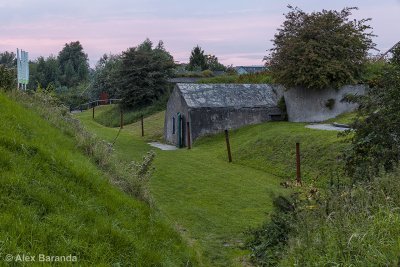
I visited one of the locations in August 2017. I was hoping to see more locations during my recent visit in November 2024, but unfortunately, I didn't get to visit any (it was raining and the wind was extremely strong).
In 2017, I visited Fort Diemerdam just outside Amsterdam. I was staying near Amsterdam Centraal. I took the #26 tram to the IJBurg stop and walked the rest of the way (about 15-20 minutes). Fort Diemerdam has a few bunkers left on the site. The site is now an events venue. Near the bunkers, there is now a pavilion (Paviljoen Puur). There was an event happening at the time I went, so there were quite a lot of people near the pavilion, but there were still a lot of bunkers to explore away from it. The pavilion looks pretty cool, though - looks like a shell.
Along with the not-so-great weather, I was also with my girlfriend the last time I was in Amsterdam. While I enjoy looking for UNESCO World Heritage Sites, this isn't for everybody, and the Dutch Water Defence Lines locations are not exactly a must-visit on any traveler's list. Also, I'm using the World Heritage - UNESCO List app, and the app only lists 9 locations. It's good to know that this site shows more locations.
Keep reading 0 comments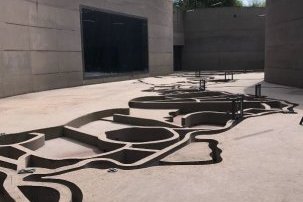
18 years after my first visit, I made the most of being based in the Netherlands for the summer to try to understand this somewhat enigmatic site.
But where to choose? Well quite by accident I hit a jackpot.
This fantastic museum just outside Utrecht focuses on the New Dutch Waterline section that runs from Muiden on the Ijmeer, south to the Waal (essentially the Rhine) river at Gorinchem. The elegant concrete brutalist bunker has been inserted into the centre of the original fort, and its central courtyard now has a beautiful concrete 3D map of the whole system that can be filled with water to fully illustrate how water defence system can be used to flood a band across the central Netherlands to protect Holland and Amsterdam from attaches from the South and East.
The museum has interactive screens and models that are partially aimed at children, but for the first time explained to me the system and how it works, in a way that finally got it beyond just a theoretical, “I think I understand it”.
Perhaps the highlight of the museum though was the VR experience that simulated a flight over the top of the whole defence system, allowing you to pick out the features of the landscape that are part of the defences or the fields that would end up inundated. It may sound slightly tacky, but this was actually the best example of a VR experience in …
Keep reading 0 comments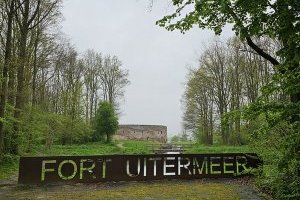
Visited in April 2024. When I was preparing for my trip to the Netherlands I realised that I've visited this site already on all my previous trips to the country. Basically every road and train line out of Amsterdam goes through the core zone of this site and I have done multiple trips out of Amsterdam before. I might have also visited some of the forts around Utrecht but that was a long time so I can't count on my memory anymore. But this time I wanted to visit the site consciously.
I chose to stop by Fort Uitermeer, near the town of Weesp. The fort was perfectly on my way to the northeast and the Unesco website had a photo of it on their website, so that made me want to stop by it. I could've stopped in more interesting Muiden or Naarden but I was strict on time so one small fort was enough for this time. Fort Uitermeer is part of both New Dutch Waterline and Defence Line of Amsterdam. It's a small circular fortification and quite funny looking because of its shape. The fort was built to protect important roads and train lines, and there is also a lock next to it, that can be used for the flooding of the fields.
On a drizzly Thursday April morning I was the only tourist around (unsurprisingly). Only one dog with its owner was exploring the paths around the fort. The fort has its own parking …
Keep reading 0 comments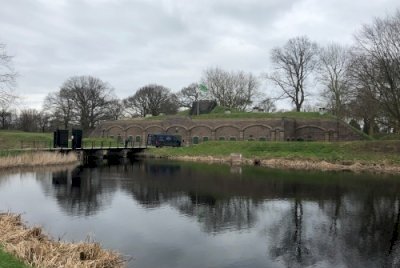
The “Nieuwe Hollandse Waterlinie” (New Dutch Waterline) is a proposed extension to the Defence Line of Amsterdam, which will be discussed at the 2020 WHC. It comprises another series of defense works, stretching out a further 85km from the southeast of the Defence Line of Amsterdam across the province of Utrecht into Gelderland and Noord-Brabant. Both used water – a 50cm layer of it, “too shallow for ships and too deep for men on horses” - to keep invaders out. The new name of the combined WHS shall become: “Dutch Water Defence Lines”.
The New Dutch Waterline actually is the better known part of the two among the general public. I had visited one of its components before – Loevestein Castle, one of the most interesting castles in Holland – but last week I headed out for a hike in the area of Fort Ruigenhoek. Ruigenhoek and 3 other forts in the vicinity were especially built to protect the city of Utrecht, which established itself more and more as a railway infrastructure hub in the 19th century. These forts replaced an earlier defence line which had become too close to the city due to its expansion in the 1860’s; hence the “New” in New Dutch Waterline.
Ruigenhoek lies so close to the city of Utrecht that it attracts lots of visitors at any moment. With all schools closed and so many people working from home due to the COVID-19 crisis, even during the weekday afternoon that I visited …
Keep reading 0 comments
If you look at our rating the Amsterdam Defence Line is not a popular WHS. In any case it offers a rather unique and interesting story which is inextricably connected to older similar defence lines, the most important of which were the Old and the New Dutch Waterline. All of them were huge enterprises including dozens of forts, dykes and sluices. They all use water which the Dutch normally have to fight against as a weapon against invading enemies. If that is not original enough they also flooded their own, mostly agricultural but also populated land on huge areas as you can see on the maps of the Dutch Waterline on Wikipedia for example, which is rather self destructive. I find it also funny that the land had to be flooded very shallowly since too low water would still allow driving and walking and to high water levels would allow boats. It is a bit surprising that the Amsterdam Defence Line was the first of these lines that made the list since one would think that the oldest lines were the revolutionary undertakings and most worth of an inscription and the later lines could be regarded as more of a imitation or continuation. As I could find out there seem to be two reasons for this: The Amsterdam Line as the newest project is the best preserved of the three. And since the older lines belong to several provinces they had supposedly a hard time to come up with a …
Keep reading 0 comments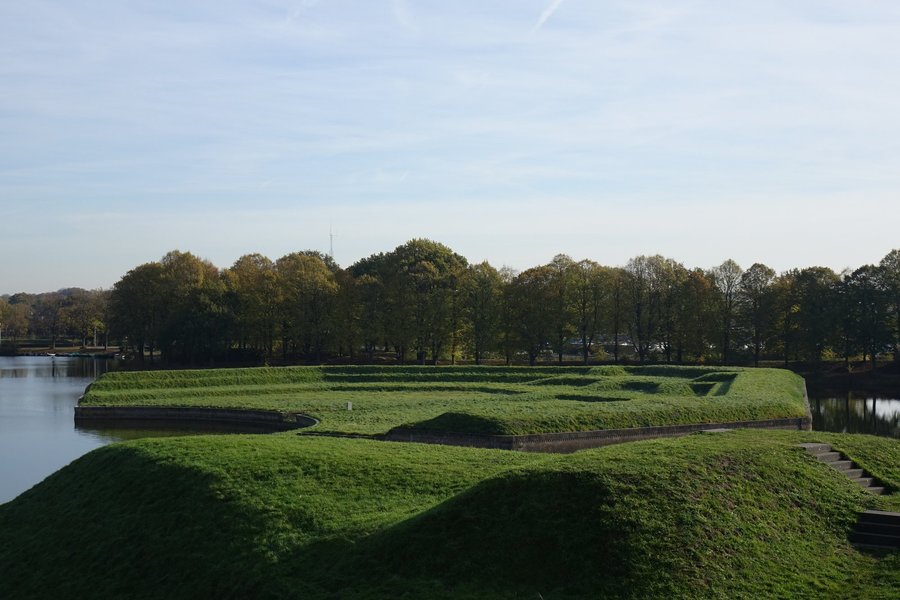
I use to study in Utrecht and walked/biked a lot in the area around the Hollandse Waterlinie. So i thought i might share with fellow travelers what they can best do in case they are ever in the area and want to see the nearby fortresses.
The fastest and easiest way to go there from Utrecht Central Station is by taking the bus to Wijk Bij Duurstede and to then get of at the busstop Oud Amelisweerd. When you step out of the bus you will see an old mansion on your left and railwaytracks/highway on your right. You want to cross the railway and go through the tunnel underneath the highway and you will see Fort Bij Vechten.
Fort bij Vechten is possibly one of the most accesible fortresses on the linie. You can freelly walk into the inner courtyard and climb on top of the walls of the fortress. Inside the fortress you can find the waterliniemuseum. Which is quite pricey (5 euro per person) but gives a clear explenation what the waterlinie was build for and how it was used for through it's history. Which might be a nice introduction.
If you walk around the fortress you will find west of it another Dutch tentative sight, the remains of the frontiers of the Roman empire. Fort bij Vechten was build on top of an old Roman castellum and they show there, through a large floorplan made out of diiferent colored bricks, how the Roman armycamp would have …
Keep reading 0 comments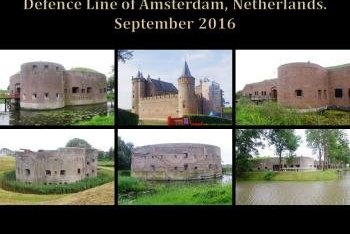
I have visited this WHS in September 2016. The Defence line of Amsterdam symbolises the engineering skills of the people from the Netherlands in water management. It also illustrates the spirit and atmosphere existing in Western Europe in the late 18th and early 19th centuries when most of countries were facing internal tensions as well as external pressures, increasing the likelihood of the occurence of a war and making necessary to all countries to erect defence lines and fortifications.
I have visited forts in Weesp, Muiden, Abcoude, Hinderdam and Nekkerweg. Other forts will come during my next trips to the Netherlands.
Keep reading 0 comments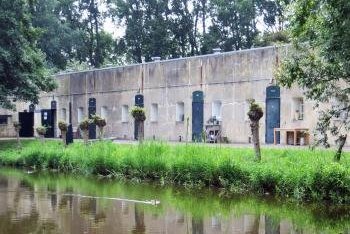
Because I had limited time in and around Amsterdam when visiting in 2014, I concentrated on a section of the Defense Line just outside Haarlem, which included Fort Liebrug and Fort Penningsveer. The walk to the forts was scenic, bypassing a recreation area on the west side of the Liede River. Both forts are on the east bank of the Liede. Fort Liebrug was closed, so I only got to see it from the road, but Fort Penningsveer was open on a Thursday afternoon in the summer. Fort Penningsveer is tree-covered and surrounded by a moat, and has several earth-covered bunkers and trails to explore. I encountered a youth camp unexpectedly on the back side of the fort, but I later found out on the Defence Line of Amsterdam website that the fort is being used for educational camps. The forts weren't the most breathtaking World Heritage Sites I've seen, but they were a pleasant way to spend a summer afternoon.
Logistics: Train to Haarlem Spaarnwoude station (near Haarlem IKEA); walking path to the east bank of the Liede River to find both Fort Liebrug and Fort Penningsveer.
Keep reading 0 comments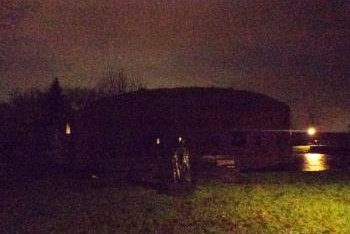
Since I was in Essen, Germany, visiting the Zolverein WHS, on 17/12, I thought I would go to Amsterdam just for one night on 18/12 to attend a concert at the Gebouw for the first time. But because I had been to Amsterdam once before, instead of roaming the city before the concert, I thought I'd go check out another World Heritage site, the Amsterdam Defense Circle. It was a last minute decision, meaning I was not well-prepared. Once in Amsterdam I just walked into a tourist office, and a staff there recommended the city of Naarden to see part of the circle, showing me the impressive aerial photo of the city.
So I went to Naarden, and it was fascinating to learn at the defense museum how the people in the low lands in Netherlands naturally came up with the idea of using water to defend themselves.
But then after the concert in my hotel I checked the UNESCO website and started wondering if Naarden is really part of the WHS, despite the fact that a staff at the museum specifically told me that the whole town of Naarden was a part of that WHS.
Because of my suspicion I quickly decided to visit the fortress at Weesp in the early next morning before my train departs from Amsterdam Central at 9 am. From the Weesp train station, I walked in the rain to the fortress at 7 am in the early morning winter darkness.
By now I know …
Keep reading 0 comments
I visited this WHS several times but I remember in December 2010 the canals were totally frozen! This defence system based on the principle of controlling the waters is quite unique and well worth a visit by boat (perhaps when the canals are not frozen!)
Keep reading 0 comments
The "Nieuwe Hollandse Waterlinie" (New Dutch Defence Line) is on the (old and new) Tentative List as an extension to the Defence Line of Amsterdam. It is also a Defence Line based on inundation. At the north, it hooks up with the Defence Line of Amsterdam near Muiden. This Defence Line (1871) was developed to replace an older one that had been protecting parts of Holland. It incorporated the defence of the city of Utrecht. It is 85km long and still very visible and in good shape.
I visited a fortress at the southern edge of this Line: Loevestein. It encloses a castle that is well known in Dutch history: it is from here that the legendary escape of the imprisoned jurist Hugo Grotius inside a book case took place.
The fortress/castle lies in a very pleasant recreation area, especially on a sunny day like this. It sits on a strategic position at two main rivers, the Meuse and Waal. The castle is enclosed by a moat, then by the fortress and another moat. It attracts quite a lot of visitors, and I noticed that it is popular with foreign tourists too. It really is a peculiar construction, such a great defence work relying totally on the force of water. It often suffered from floodings itself too. The castle is made of connected tower houses and has only a tiny courtyard.
The area around it is now a protected landscape. There are bike paths and hiking trails. A good place …
Keep reading 0 comments
This is a pretty interesting and unique site, but one that is a bit challenging to visit. It consists of over 30 separate sites within a 15 to 20-km radius around Amsterdam, all in various states of repair, with many not accessible to the public. The highlight is the small (artificial) island of Pampus in the IJsselmeer, which can be reached by ferry from Muiden. The military and civilian installations there are still very impressive and give a good idea of what life was like for the soldiers stationed there (it was only fully staffed during WW I). The guided tours seem to be in Dutch only, but you can get a map and walk around on your own. The pretty port city of Muiden has a nice maritime atmosphere and features, besides the interesting Muiden Castle, another part of the WHS - the Muizenfort, which includes some well-preserved trenches. The West Battery is directly opposite the castle and can be seen from the ferry (it would be a very long walk there). In the nearby town of Weesp (where the buses to Muiden leave), I went to see the Fort aan de Ossenmarkt, which looks quite impressive and well-preserved from the outside, but can't be visited. These sites are all southeast of Amsterdam and seem to be the ones that can be visited most easily. After my visit to Beemster (north of A'dam), I went to the nearby town of Edam, which is most famous for its cheese-making tradition. …
Keep reading 0 comments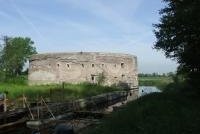
Although a number of the forts were closed I did manage to visit a few of them:
Aalsmeer fort - got a guided tour from the curator of the museum here, saw the facilities provided for the troops stationed here virtually undergound and enclosed in a massive reinforced concrete structure (train to Schiphol Airport then bus #198 to Aalsmeerdenbrug).
Fort Uitermeer - a circular fort (train to Weesp then bus #106 to Rondelvrugt.
Vesting Weesp - a circular fort (train to Weesp)
Muiden Slot - has more an appearance of a stately home or castle than a defence installation (by bus from Weesp).
Pampus Island - the ferry ride from Muiden included an extensive guided tour of the fort.
Amstelhoek fort - by bus #142 from Amsterdam Centraal to Tienboerenweg, Uithoorn.
Fort an der Drecht - now a restaurant, winery and art studio (bus #170 from Uithoorn).
Fort Vijfhuizen - now an art centre (by bus #140 from Uithoorn to Hoofddorp then bus #300).
Fort Veldhuis and Fort an der Ham - found these on a hike along the dykes from Heemskerk (bus #167 from Beverwijk station) to Krommenie-Assendelft station.
Keep reading 0 comments
Some friends of mine invited me to go to Amsterdam with them. Since I had seen Amsterdam before, I decided to visit the defense line. Our stay wasn’t going to be long and I was going to rely on public transportion. So I decided to search on the internet which parts of the defense line were the easiest to reach from the city. Combining the world heritage website, google maps, some others and this very excellent site on the defense line (in Dutch and English) I choose the following fortresses:
- Fort aan de Ossenmarkt (Weesp)
- All the fortresses in the town of Muiden
- Fort bij Penningsveer (Haarlemmerliede)
- Fort aan den Ham (Uitgeest)
First I took the train from Amsterdam Central station to Weesp Station (+/- 15 min) and from there I took the bus to Muiden (stop brandweerkazerne: +/- 10 minutes). There I saw the complex of sluices, the westbattery, Muizenfort and I also visited the nicely preserved Muiderslot (which I can recommend taking some time for). Unfortunatly the boat to Pampus didn’t sail out this season, so I could only glimpse it from the shores of the Ijssel lake.
The thing I liked most here was the west battery, I found it to be an intruiging structure. Unfortunatly I could only see it from outside, as the inside seems to be used for youth organisations. The muizenfort contains a museum, but this too was closed. Muiden is a nice town though with a nice maritime …
Keep reading 0 comments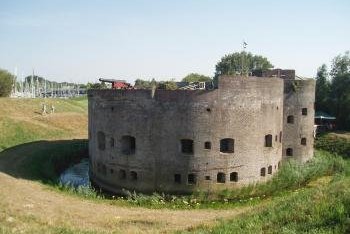
The forts ring Amsterdam so if you travel about 15km out from the centre you will be pretty close to one of them.
After a recommendation from Els we headed out to Muiden. There are two forts here as well as a ferry link to a third at Pampus. We first stopped at the Muiden fort near the lock at the centre of town. Having looked at the forts in aerial photos this was the classic shape of the majority of the forts, it is a sort of arrowhead shape surrounded by a moat. We had a look inside but most of the things were closed, there was information leaflets about the other forts along the New Holland Waterline (on the Dutch tentative list).
We then walked out to the West battery (pictured), here you could get a better overview of the fort and its ring of water, it is now used as a meeting place for scouts. It was very hot so we went to the extremely small beach behind the battery and relaxed with the locals, looking out towards the fortress island of Pampus.
Muiden was an exceedingly charming place to visit and the castle is very impressive, we had a lovely time here sitting in the café next to the lock watching the boats move past. It was worth making the short trip out, there are hourly buses to and from Amsterdam Amstelstation and it takes about 30 minutes.
We saw three of the forts at Beemster, …
Keep reading 0 comments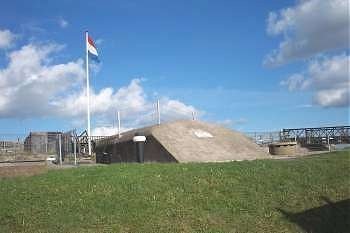
For my visit to the Defense Line, I chose Muiden and Pampus, two of the most accessible locations. Muiden is a historical fortress-town to the east of Amsterdam. The whole town is like an open-air museum and has a real historical feel to it. The Muiden Castle is also a must.
From Muiden I took the ferry to Pampus. This island became the final part of the Defense Line: it had to guard the entrance to Amsterdam via the IJ-river. Soldiers were trained here between the two World Wars, but never has the island been used in combat. The place was already outdated when its construction had finished.
Nowadays Pampus sees 35.000 visitors a year. Since 1990 it has been privately owned by a foundation that wants to maintain and restore the fortress island. They haven't been lucky in finding funds though, and so the site is in really bad repair. Not as bad however as when they acquired it twelve years ago when there were rats everywhere and trees grew out of the buildings.
Keep reading 0 comments
